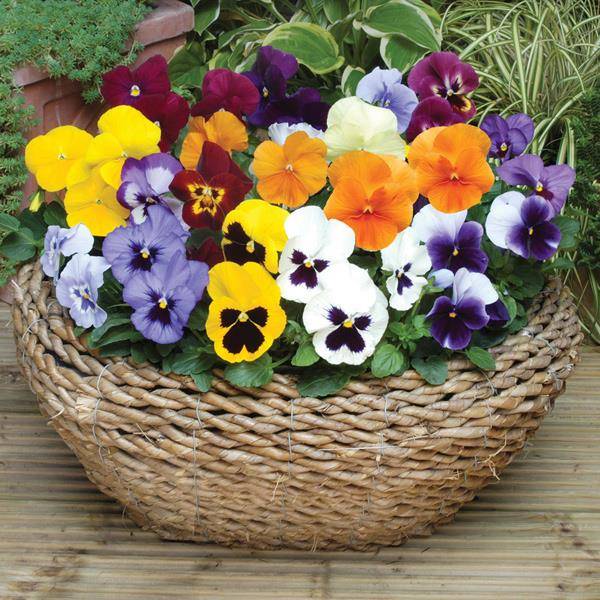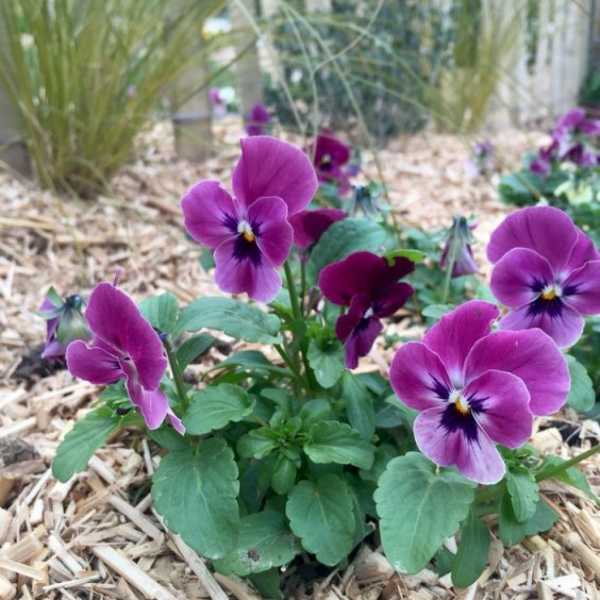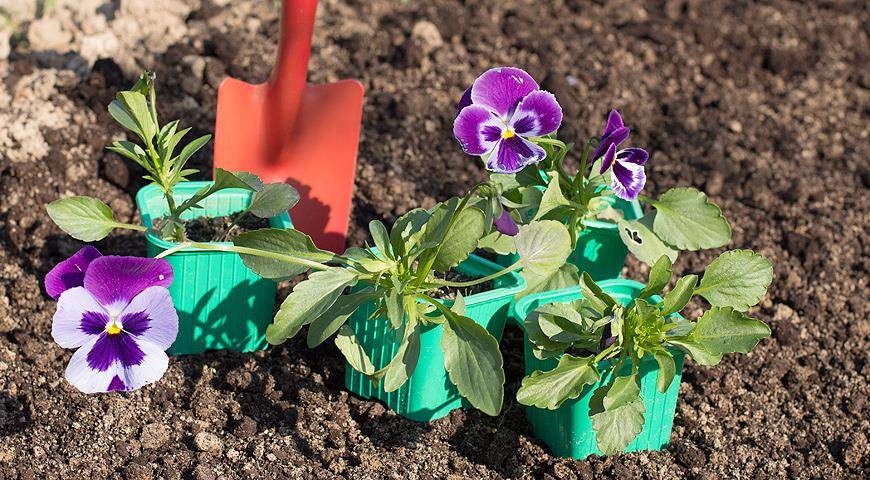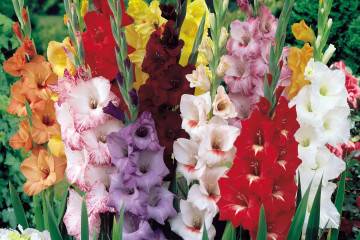Viola flowers
Content:
Viola are flowers that belong to the Violet family. Grows in areas with a temperate climate. Has adapted to the conditions of the mountainous regions of the northern countries. Combines from 400 to 700 varieties. Below is how to plant and then care for it.
The origin and appearance of the viola plant
The plant can be found all over the world, in:
- South Africa;
- Brazil;
- Australia;
- New Zealand.
It gained its popularity several centuries ago. It is known in Europe for more than 2.5 thousand years. Since ancient times, wreaths and garlands have been decorated with it, as well as premises during the holidays.
Violets have been breeding since 1683. First they got fragrant, and then mountain ones. In Europe, the viola species appeared in the 19th century. It was obtained by crossing three varieties: Altai, tricolor and yellow.
Today it is one of the most popular plants among gardeners. It has hundreds of varieties. In flower shops, prices for a bag of viola seeds start at 18 rubles. *
Viola plant description
The root system of the flower is fibrous, the shoots are erect. They grow as a rosette or individually. The buds open one at a time. Their color is solid, spotted or striped. The culture blooms in May and August. Why some bloom once a season, others all year round, depends on the planting of seeds. The fruit of the flower resembles a box of seeds.
Many are interested in whether viola flowers are perennial or annual? It is a perennial plant. It is used in decorating landscape design. Bushes can reach a height of up to 30 cm.
Types and varieties of viola
Viola (violet) flowers are known as pansies. They resemble "muzzles". There are 700 plant species. The varieties are suitable for potted and outdoor cultivation.
Viola Valentino
Viola Valentino is a common species. It has small flowers on long stems. The color is very diverse: from white and purple to blue and lavender.
Viola Wittroca
Viola Wittrockiana is an equally popular viola variety. Most often you can find in markets and flower shops. This is a flower created by crossing Altai viols, yellow, horned and other species. Bushes are erect, they reach 30 cm in height. The leaves are oval with teeth. Flowers can be up to 11 cm in diameter in different shades. The petals have streaks, lines, spots.
Viola da gamba
This violet has the ability to bloom in one place for many years without losing its beauty. It endures winter staunchly. Hybrids need protection and proper care.
The variety has small flowers, lilac, lilac, yellow, orange and red shades. Large spur 15 cm.
Viola horned
Viola Cornuta is popularly called horned viola. It differs from other varieties in the curved spur at the back of the flower. Inflorescences 5 cm in diameter. Their color is lilac, blue, violet with a yellow spot in the middle.Hybrids can be blue, white, cream, orange, yellow, and red. Flowers exude scent. The species is grown in pots, outdoors, on borders and flower beds.
Viola Davis
Viola Davis grows no more than 30 cm. The leaves have stipules. Peduncles bloom flowers 7 cm in diameter. They combine several shades, diluted with stripes and spots.
Ferro Network
Ferro Network is a perennial herbaceous hybrid of viola. Reminiscent of terry lace. Both perennial and annual grows. Propagated by seeds and cuttings. Feels great even in shaded areas. Requires regular watering and weed removal.
Large-flowered
It is also called the Swiss giant. It reaches a height of no more than 30 cm. The leaves have stipules. Flowers up to 7 cm in diameter form on long peduncles. It can be distinguished from other species by color and shape. They come in different colors, with stripes and spots.
Steels
The people were nicknamed the ballerina. The variety originated from the Mediterranean and Asia Minor. Flowers bloom in spring in purple, white and variegated shades. Has medicinal properties in the fight against:
- colds;
- asthma;
- infectious diseases;
- rheumatic pains.
It has a rich aroma. Used in perfumery.
How to grow viola
Cultivation takes place according to 3 schemes:
- from seeds;
- planting seeds for seedlings;
- through seedlings in the open field.
Growing viola from seeds
You can plant it directly in open ground, but experienced flower growers do it in pots, growing seedlings. They begin to do this at the end of February. Several seeds are thrown into the finished soil mixture and covered with earth. The seeds are pre-soaked in an epin solution. The soil is watered abundantly with water, covered with foil and kept at a temperature not lower than 15 ° C.
Seedlings can be expected after 1.5 weeks. Containers with seedlings are freed from the film and transferred to a cool place with bright lighting. Young shoots are afraid of direct sunlight. For the full development of sufficient watering and fertilization of the soil 2 times a month.
Planting seedlings grown from seeds in open ground
Landing in open ground is a simple procedure. It is carried out in a certain sequence, using the necessary tools (shovels, rakes, etc.).
A phased disembarkation is as follows:
- Wells are prepared at a distance of 10 cm from each other.
- Sprouts are planted and sprinkled with soil.
- The earth is rammed and everything is watered abundantly.
Planting viola seedlings in open ground
The time for planting a flower in open ground depends on the weather conditions. The site must be well lit. The soil is fertilized with crushed coal, humus, poultry droppings in proportions 1: 1.
To protect the roots from decay, they choose a place for planting on a small hill, where groundwater passes at great depths.
What is needed for landing
For landing you will need:
- scapula;
- special land (fertilized or bought in a specialized store);
- water.
Choosing the best place
Viola is a flower that is unpretentious, but you shouldn't abuse it. An ideal planting site would be a high flower bed. It meets the necessary requirements of a flower: moderately moisturized and illuminated. Also, flowers can be grown on the balcony, dacha in a planter or pot. It is better to choose a place for planting in the shade. A plant under the sun will wither. The air temperature should be no higher than 20 ° С.
Viola planting scheme in a flower bed
Pansies can be grown in the form of flower arrangements, that is, combine several varieties in one planting in a certain order. For example, plant white and purple violets in a checkerboard pattern. Many will appreciate this idea.
Step-by-step planting process
An important step in planting a viola is soil preparation. It should be moisturized, nourished and warm.
How to make it yourself:
- Mix peat, humus and earth in equal proportions.
- Add sand (1/2 of one of the previous ingredients).
Mix everything thoroughly and use to fill the planting holes.
Planting process:
- Dig holes up to 15 cm deep.
- Plant the plant with soil, sprinkle with prepared substrate and compact with your hands.
- Water abundantly.
- Mulch with organic matter.
Viola care
Despite being easy to grow, violets need to be cared for. Proper watering, optimal temperature and humidity are all very important.
Watering mode
A common cause of drying out is the wrong location. If a violet is not planted at the correct depth, its root system is not getting enough water. To balance this situation, regular watering is carried out. It is produced 2-3 times a week, but in moderation. In the hot season, irrigation is done every day.
How to feed viola for abundant flowering
Used as bait:
- superphosphates;
- ammonium nitrate;
- complex fertilizers - nitrogen, phosphorus, potassium;
- trace elements.
Viola is fertilized once a month. Fertilizers can be purchased at specialized stores and used according to instructions.
Features of care during the flowering period
During the flowering period, the violet needs special care.
- Fertilizers (potassium and phosphorus) are applied before planting.
- After the formation of buds, they are fed with nitrophos in a proportion of 1 tbsp. spoon for 10 liters of water.
- During flowering, the roots are watered with agriculture.
Features of care during the rest period
During the dormant period, a standard irrigation and fertilization regime is recommended. If desired, you can remove dried flowers and stems.
Preparing for winter
In the first year, all viols need shelter for the winter. Warming is carried out using straw and dry branches. They act as defenders of the root system from the cold.
Thus, there is nothing difficult in growing this flower. Taking into account the recommendations for planting, care and reproduction, you can enjoy the flowering of viola for a long time.
* Prices are for September 2019





















